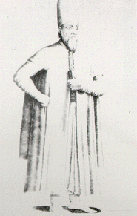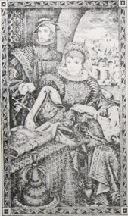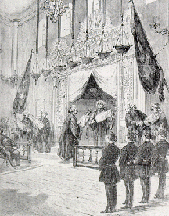The Life of Ottoman Jews
For 300 years following the expulsion, the prosperity and creativity of the Ottoman Jews rivaled that of the Golden Age of Spain. Four Turkish cities: Istanbul, Izmir, Safed and Salonica became the centers of Sephardic Jewry.
Most of the court physicians were Jews: Hakim Yakoub, Joseph and Moshe Hamon, Daniel Fonseca, Gabriel Buenauentura to name only very few ones.
One of the most significant innovations that Jews brought to the Ottoman Empire was the printing press. In 1493, only one year after their expulsion from Spain, David & Samuel ibn Nahmias established the first Hebrew printing press in Istanbul .
Ottoman diplomacy was often carried out by Jews. Joseph Nasi, appointed the Duke of Naxos, was the former Portuguese Marrano Joao Miques. Another Portuguese Marrano, Aluaro Mandes, was named Duke of Mytylene in return of his diplomatic services to the Sultan. Salamon ben Nathan Eskenazi arranged the first diplomatic ties with the British Empire. Jewish women such as Dona Gracia Mendes Nasi "La Seniora" and Esther Kyra exercised considerable influence in the Court.



Left: Jewish Doctor - 1568 (Woodcut from "Nicolay de Nicolay", page 185), Middle: Dona Gracia Nasi & Joseph Nasi (Woodcut from "Les Demiers Jours de Shylock", page 88), Right: Prayer offered for the Victory of Turkish armies in the war against Russia with the presence of the Sadrazam (Prime Minister) Ibrahim Edhem Pasha Ahrida Synagogue (London Illustrated News 9.6.1877)
In the free air of the Ottoman Empire, Jewish litterature flourished. Joseph Caro compiled the Shulhan Arouh. Shlomo haLevi Alkabes composed the Lekhah Dodi a hymn which welcomes the Sabbath according to both Sephardic and Ashkenazi ritual. Jacob Culi began to write the famous MeAm Loez. Rabbi Abraham ben Isaac Assa became known as the father of JudeoSpanish literature.
On October 27,1840 Sultan Abdulmecid issued his famous ferman concerning the "Blood Libel Accusation" saying: "... and for the love we bear to our subjects, we cannot permit the Jewish nation, whose innocence for the crime alleged against them is evident, to be worried and tormented as a consequence of accusations which have not the least foundation in truth...".
Under Ottoman tradition, each nonMoslem religious community was responsible for its own institutions, including schools. In the early 19th century, Abraham de Camondo established a modern school, "La Escola", causing a serious conflict between conservative and secular rabbis which was only settled by the intervention of Sultan Abdulaziz in 1864. The same year the Takkanot haKehilla (By-laws of the Jewish Community) was published, defining the structure of the Jewish community.
An important event in the life of Ottoman Jews in the 17th century was the schism led by Sabetay Sevi, the pseudo Messiah who lived in Izmir and later adopted Islam with his followers.
Next> Equality and a new Republic